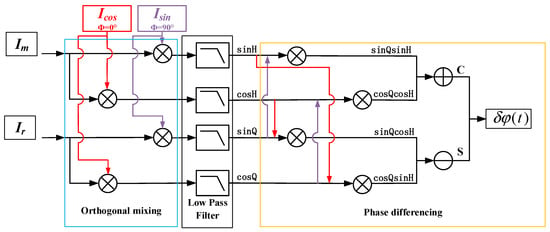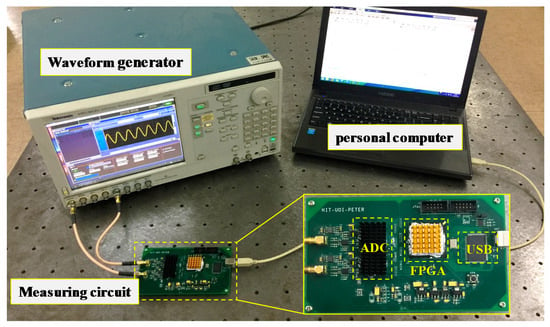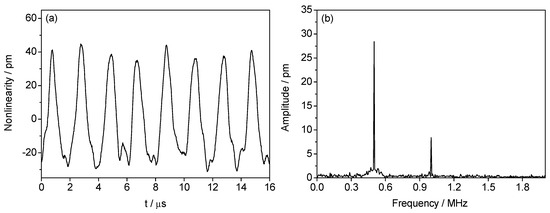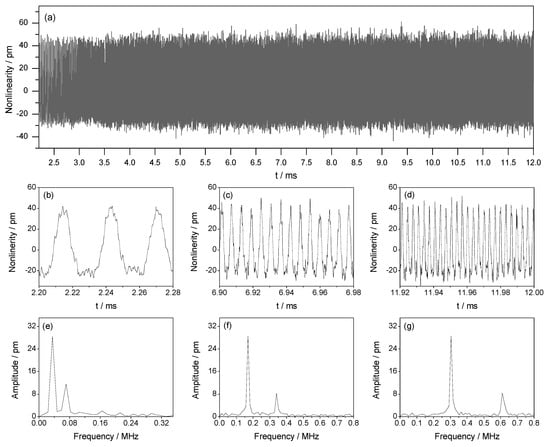Abstract
The phase quadrature measurement method is capable of measuring nonlinearity in heterodyne laser interferometers with picometer accuracy whereas it cannot be applied in the new kind of heterodyne interferometers with bidirectional Doppler frequency shift especially in the condition of non-uniform motion of the target. To solve this problem, a novel measurement method of nonlinearity is proposed in this paper. By employing double-channel quadrature demodulation and substituting the external reference signal with internal ones, this method is free from the type of heterodyne laser interferometer and the motion state of the target. For phase demodulation, the phase differential algorithm is utilized to improve the computing efficiency. Experimental verification is carried out and the results indicate that the proposed measurement method achieves accuracy better than 2 pm.
1. Introduction
Heterodyne laser interferometers are widely applied in precision metrology, nanotechnology, and lithography due to their high accuracy and robustness [1,2,3]. With the development of science and technology, it is badly in need of laser interferometers with picometer accuracy [4] such as the next-generation laser interferometers. However, the improvement of the measurement accuracy of heterodyne laser interferometers is seriously restricted by the nonlinearity [5,6,7], i.e., the periodic nonlinear error. The measurement method of nonlinearity as an indispensable auxiliary tool plays an essential role in developing the next-generation laser interferometers.
Several methods for measuring the nonlinearity of heterodyne laser interferometers have been developed [8,9,10]. The most widely used method is the frequency domain method [8]. This method is simple and convenient to operate, but it is only applicable to the cases with constant velocity. Moreover, limited by the background noise of the spectrometer, picometer accuracy is not available for this method. Another method is the displacement comparison method [9] when compared to an identical displacement. By subtracting the result of an X-ray interferometer from that of a laser interferometer, the nonlinearity can be obtained. Picometer accuracy is easily achieved by this method while the X-ray interferometer is difficult to be replicated due to technique and cost issues and the measurement process is complex because of the special property of X-rays. Benefited from lock-in amplification, the phase quadrature measurement method [10] is promising in a nonlinearity measurement up to picometer accuracy. In this method, the reference signal of the interferometer serves as the external reference signal of a lock-in amplifier in which there is a phase-locked loop that tracks the frequency of the external reference signal. Then a pair of quadrature signals with the same frequency are generated internally for the phase demodulation. The frequency of the external reference signal is expected to keep constant or to vary slowly. Otherwise, the phase-locked loop might work in the tracing state rather than the locked state [11], which will cause an error for phase demodulation. For the traditional heterodyne laser interferometers, the frequency of the reference signal is of constant frequency, i.e., the split frequency of the laser source, so there is no such problem. For the next generation heterodyne laser interferometers [12,13], most of them adopt an optical configuration with bidirectional Doppler frequency shift (DFS), i.e., the measurement and reference signals have equal DFS but come with an opposite sign. When the target is in fast and non-uniform motion, the frequency of the reference signal will change rapidly. In this case, the existing phase quadrature measurement method is not applicable.
This paper presents a novel measurement method for nonlinearity in heterodyne laser interferometers, which adopts the architecture of double-channel quadrature demodulation with internal references and, thereby, is able to break through the limits in type of heterodyne laser interferometers and in motion state of the target. In addition, the phase differential algorithm is utilized to improve the computing efficiency. Experiments are carried out to verify the performance of the proposed method.
2. Measurement Method for Nonlinearity Based on Double-Channel Quadrature Demodulation
The nonlinearity in heterodyne laser interferometers originates from the frequency mixing in the reference and measurement arms [14,15,16]. In recent years, to avoid the nonlinearity, heterodyne interferometers with spatially separated optical paths have been developed [12,13]. In this kind of interferometers, the reference and measurement beams with slightly different frequencies are separated spatially before interference. In theory, there is no frequency mixing and, thereby, the nonlinearity can be completely avoided. However, an experimental study reveals that there is still nonlinearity in this kind of interferometer and its source is ascribed to the multi-order DFS induced by ghost reflection [17,18], i.e., the laser beams are repeatedly reflected between the beam splitter and the target. To improve the resolution by a factor of two, this kind of heterodyne laser interferometer usually adopts an optical layout with bidirectional DFS. Figure 1 shows the schematic of the formation mechanism of the reference and measurement signals in this type of interferometer. Considering the multi-order DFS, the reference and measurement signals can be expressed by the equation below.
where A and B are the amplitudes of the intended reference and measurement signals, respectively. and are the amplitudes of the mth and nth order nonlinear harmonics in the reference and measurement signals, respectively, generally and . is the beat frequency, and are the optical frequencies of the dual-frequency laser source. = −(m + 1) and = (n + 1). is the measured phase and can be calculated by using Equation (2).
where is the DFS.

Figure 1.
Schematic of formation mechanism of the reference and measurement signals in heterodyne laser interferometers with spatially separated optical paths and bidirectional DFS. BS: beam splitter, MA: measurement arm, RA: reference arm, DFS: Doppler frequency shift, INF: interference.
As indicated by Equation (1), the reference and measurement signals for the new type interferometer have equal DFS but come with an opposite sign. Therefore, the frequency of the reference signal is also determined by the motion state of the target. When the target is in non-uniform motion, the frequency of the reference signal is not constant. As mentioned above, in this case, the existing phase quadrature measurement method is not applicable. To solve this problem, a novel measurement method of nonlinearity based on a double-channel quadrature demodulation is presented, which is illustrated in Figure 2. This is realized in the field programmable gate array (FPGA). Compared with the traditional phase quadrature measurement method, there are two key distinctions. The first distinction is that the traditional method is based on a single lock-in amplifier while the new method adopted two lock-in amplifiers (a lock-in amplifier mainly consists of two mixers and two low pass filters). The second distinction is that, in the traditional method, the reference signal of the interferometer serves as the external reference of the lock-in amplifier while, in the new method, the external reference signal is abandoned. Instead, a pair of quadrature signals generated inside the FPGA are used as the reference signals of the lock-in amplifiers and both the reference and measurement signals of the interferometer serve as the measurement signals of the two amplifiers.

Figure 2.
Schematic of the measurement method for nonlinearity in heterodyne laser interferometers based on a double-channel quadrature demodulation.
The two quadrature signals generated inside the FPGA can be expressed as and where is the angular frequency. As shown in Figure 2, in the first step, the internally generated quadrature signals are mixed with reference and measurement signals of the heterodyne interferometer, respectively. This operation is performed by four mixers. After low pass filtering, the output of the mixers can be expressed by the equation below.
Based on Equation (3), the cosine component C(t) and sine component S(t) can be calculated using the formula below.
then the amplitude and phase can be calculated using Equations (5) and (6).
and
As the reference and measurement signals, Im and Ir have equal but opposite DFS. The theoretical phase difference between them is . Therefore, the measurement error of phase is shown below.
By using the first order approximation of the Taylor expansion for Equation (6), Equation (7) is expressed by the formula below.
Similarly, R(t)/R(t) can be expressed by the equation below.
where is the amplitude when . Equations (8) and (9) are similar in mathematical expressions except for a 90° phase delay. Thus, in real applications, to evaluate the nonlinearity, we can calculate R(t)/R(t) rather than since the calculation of R(t)/R(t) are much easier to realize in practical applications. As shown by Equation (7), to calculate the phase error , it is necessary to know the real phase . However, this is not easy to realize in practical applications because it is extremely difficult to provide a controlled displacement at nanometer or sub-nanometer level. Actually, in most of the practical applications, the real phase is an unknown value. However, for calculating , it is not necessary to know the real phase. To evaluate the system nonlinearity, the phase delay is a negligible factor. Therefore, the nonlinearity can be calculated by the equation below.
where M is the optical fold factor and is the laser wavelength for the heterodyne laser interferometers with bidirectional DFS, M = 4. For digital signals, R(t)/R(t) can be calculated by the formula below.
where
The above analysis shows the overall procedure of the proposed method for measuring the nonlinearity in heterodyne laser interferometers. By adopting internal references for the lock-in amplifiers, this method avoids the problems induced by frequency variation of external references, which means it is no longer limited by the motion state of the target. By utilizing double-channel quadrature demodulation, the method can be applied extensively to the new type heterodyne laser interferometers with bidirectional DFS. In addition, for phase demodulation, it is not a simple subtraction of the measured phases of the two lock-in amplifiers. Instead, the phase differential algorithm is employed to improve computing efficiency.
3. Experiment Validation
To verify the proposed method, an experimental setup was established, which is shown in Figure 3, where the waveform generator (Tektronix, AWG5012C, Beaverton, OR, USA) is used to generate two signals that simulate the reference and measurement signals of the heterodyne laser interferometers. The measurement of the nonlinearity is performed by the measuring circuit in which the two signals from the waveform generator are first converted into digital signals by the analog-to-digital converters (ADC) (AD9446, Analog Devices, Norwood, MA, USA) and then are processed in the FPGA (EP3C120F780C8, Altera Corporation, Santa Clara, CA, USA). The method described in Section 2 is realized in the FPGA and the results are sent to the personal computer through a Universal Serial Bus (USB).

Figure 3.
Experimental setup for validating the proposed measurement method of nonlinearity in heterodyne laser interferometers. ADC, analog-to-digital converter, FPGA, Field-Programmable Gate Array, USB, Universal Serial Bus.
3.1. System Performance in Condition of Uniform Motion
To study the performance of the measurement system when the target is in uniform motion, the waveform generator produced two simulated signals, which are shown below.
In Equation (13), only the first-order and second-order nonlinear harmonics are retained because the higher order nonlinear harmonics are relatively quite small [12]. When the target moves at a constant velocity , the measured phase is calculated by the equation below.
where = 632.8 nm.
In Equation (13), the reference signal consists of the main reference signal (MRS) and the parasitic reference signals (PRS1–2) and the frequency of MRS, PRS1, and PRS2 are , , and , respectively. Similarly, the measurement signal consists of the main measurement signal (MMS) and the parasitic measurement signals (PMS1–2) and the frequency of MMS, PMS1, and PMS2 are , and , respectively. In this experiment, the beat frequency and the DFS are set as 5 MHz and 0.5 MHz, respectively. The equivalent velocity of the target is 0.1582 m/s. The ratio between the amplitudes of MRS, PRS1, and PRS2 is set as 10,000:6:2. For MMS, PMS1, and PMS2, the ratio of the amplitudes is also set as 10,000:6:2. By substituting these values into Equations (9) and (10), the theoretical magnitudes for the first-order and second-order nonlinearities are calculated as 30.2 pm and 10 pm, respectively. Figure 4a,b show the corresponding experimental results in time domain and frequency domain, respectively. The overall nonlinearity shown in Figure 4a is the superposition of the first-order and second-order periodic errors. By employing the Fast Fourier Transform (FFT) to the data in Figure 4a, the frequencies and amplitudes for the first-order and second-order nonlinearities can be determined. As shown in Figure 4b, the frequency and amplitude for the first-order nonlinearity are 0.5 MHz and 28.42 pm, respectively. For the second-order nonlinearity, the frequency and amplitude are 1.0 MHz and 8.42 pm, respectively. Therefore, in this case, the measurement errors for the first-order and second-order nonlinearities are 1.78 pm and 1.58 pm, respectively.

Figure 4.
Experimental results of nonlinearities in condition of uniform motion with . (a) Time domain and; (b) frequency domain.
3.2. System Performance in Condition of Non-Uniform Motion
To study the performance of the measurement system when the target is in non-uniform motion, the waveform generator produced two simulated signals identical to that in Equation (13). When the target moves with a constant acceleration a, the measured phase is calculated by the equation below.
In this experiment, the beat frequency is set as 5 MHz and the target acceleration is set as 5 m/s2. In the reference signal Ir, the ratio between the amplitudes of MRS, PRS1, and PRS2 is set as 10,000:6:2. In the measurement signal Im, the ratio between the amplitudes of MMS, PMS1, and PMS2 is also set as 10,000:6:2. With these given values, the theoretical magnitudes of the first-order and second-order nonlinearities can be calculated as 30.2 pm and 10 pm, respectively. Figure 5a shows the measured nonlinearities in the time domain with the sampling times of 9.8 ms. Figure 5b–d is the partial enlarged drawings of the beginning, middle, and end parts of Figure 5a. The time length of each part is 0.08 ms. It can be seen that, with the increase of time, the period of the measured nonlinearity decreases, which indicates an accelerated motion of the target. Since the time length in Figure 5b–d is very short, the target velocity in each panel can be considered constant. By applying the FFT to the data in Figure 5b–d, the first-order and second-order nonlinearities can obtained, which are presented in Figure 5e–g, respectively. The frequencies of the first-order nonlinearity in Figure 5e–g are 0.035 MHz, 0.170 MHz, and 0.305 MHz, respectively, and the corresponding amplitudes are 28.50 pm, 28.61 pm, and 28.57 pm, respectively. Similarly, the frequencies of the second-order nonlinearity in Figure 5e–g are 0.070 MHz, 0.340 MHz, and 0.610 MHz, respectively, and the corresponding amplitudes are 11.61 pm, 8.35 pm, and 8.39 pm, respectively. Both the first-order and second-order nonlinearities calculated from the above-mentioned three parts are close to the theoretical values and the max measurement error is about 1.7 pm, which indicates a good reliability of the proposed method.

Figure 5.
Experimental results of nonlinearities in condition of non-uniform motion with . (a) time domain; (b–d) partial enlarged drawings for the beginning, middle, and end parts of (a) with time length of 0.08 ms; (e–g) spectrums of (b–d), respectively.
4. Conclusions
Measurement method of nonlinearity plays an essential role in the development of the heterodyne laser interferometers with ultra-high accuracy. The application of the existing methods is restricted by the type of interferometers and the motion state of the target. To break through these limits, a novel measurement method is proposed in this study. By employing the double-channel quadrature demodulation together with internal reference signals, this method is free from the heterodyne laser interferometer and the motion state of the target. Additionally, for phase demodulation, the phase differential algorithm is utilized to improve the computing efficiency. The experimental results show that the proposed measurement method achieves accuracy better than 2 pm. This method is expected to benefit the development of the next-generation laser interferometers.
Author Contributions
Data curation, Y.W. Investigation, H.F. and R.J. Supervision, G.W. and J.T. Validation, H.F., R.J., and P.H. Writing-original draft, H.F., R.J., and P.H. Writing-review & editing, G.W. and J.T.
Funding
This research was financially supported by the National Natural Science Foundation of China (NSFC) (51875140, 51675138), the China Postdoctoral Science Foundation (2017T100234), and the National Science and Technology Major Project (2017ZX02101006-005).
Conflicts of Interest
The authors declare no conflict of interest.
References
- Estler, W.T. High-accuracy displacement interferometry refin air. Appl. Opt. 1985, 24, 808–815. [Google Scholar] [CrossRef] [PubMed]
- Bosse, H.; Wilkening, U. Developments at PTB in nanometrology for support of the semiconductor industry. Meas. Sci. Technol. 2005, 16, 2155–2166. [Google Scholar] [CrossRef]
- Manske, E.; Jäger, G.; Hausotte, T.; Fusharpl, R. Recent developments and challenges of nanopositioning and nanomeasuring technology. Meas. Sci. Technol. 2012, 23, 074001. [Google Scholar] [CrossRef]
- Meskers, A.J.; Voigt, D.; Spronck, J.W. Relative optical wavefront measurement in displacement measuring interferometer systems with sub-nm precision. Opt. Express 2013, 21, 17920–17930. [Google Scholar] [CrossRef] [PubMed]
- Sutton, C.M. Non-linearity in length measurement using heterodyne laser Michelson interferometry. J. Phys. E Sci. Instrum. 1987, 20, 1290–1292. [Google Scholar] [CrossRef]
- Wu, C.; Su, C. Nonlinearity in measurements of length by optical interferometry. Meas. Sci. Technol. 1996, 7, 62–68. [Google Scholar] [CrossRef]
- Cosijns, S.J.A.G.; Haitjema, H.; Schellekens, P.H.J. Modeling and verifying non-linearities in heterodyne displacement interferometry. Precis. Eng. 2002, 26, 448–455. [Google Scholar] [CrossRef]
- Badami, V.G.; Patterson, S.R. A frequency domain method for the measurement of nonlinearity in heterodyne interferometry. Precis. Eng. 2000, 24, 41–49. [Google Scholar] [CrossRef]
- Pisani, M.; Yacoot, A.; Balling, P.; Bancone, N.; Birlikseven, C.; Celik, M.; Flügge, J.; Hamid, R.; Köchert, P.; Kren, P.; et al. Comparison of the performance of the next generation of optical interferometers. Metrologia 2012, 49, 445–467. [Google Scholar] [CrossRef]
- Wu, C.; Lawall, J.; Deslattes, R.D. Heterodyne interferometer with subatomic periodic nonlinearity. Appl. Opt. 1999, 38, 4089–4094. [Google Scholar] [CrossRef] [PubMed]
- Seefeldt, J.D. Circuit to Reset a Phase Locked Loop after a Loss of Lock. U.S. Patent Grant No. 7423492, 9 September 2008. [Google Scholar]
- Joo, K.N.; Ellis, J.D.; Spronck, J.W.; van Kan, P.J.; Schmidt, R.H.M. Simple heterodyne laser interferometer with subnanometer periodic errors. Opt. Lett. 2009, 34, 386–388. [Google Scholar] [CrossRef] [PubMed]
- Weichert, C.; Köchert, P.; Köning, R.; Flügge, J.; Andreas, B. A heterodyne interferometer with periodic nonlinearities smaller than ±10 pm. Meas. Sci. Technol. 2012, 23, 2910–2916. [Google Scholar] [CrossRef]
- Bobroff, N. Recent advances in displacement measuring interferometry. Meas. Sci. Technol. 1993, 4, 907–926. [Google Scholar] [CrossRef]
- Quenelle, R.C. Nonlinearity in interferometer measurements. Hewlett-Packard J. 1983, 34, 10. [Google Scholar]
- Hou, W.; Wilkening, G. Investigation and compensation of the nonlinearity of heterodyne interferometers. Precis. Eng. 1992, 14, 91–98. [Google Scholar] [CrossRef]
- Hu, P.; Wang, Y.; Fu, H.; Zhu, J.; Tan, J. Nonlinearity error in homodyne interferometer caused by multi-order Doppler frequency shift ghost reflections. Opt. Express 2017, 25, 3605–3612. [Google Scholar] [CrossRef] [PubMed]
- Fu, H.; Wang, Y.; Hu, P.; Tan, J.; Fan, Z. Nonlinear errors resulting from ghost reflection and its coupling with optical mixing in heterodyne laser interferometers. Sensors 2018, 18, 758. [Google Scholar] [CrossRef] [PubMed]
© 2018 by the authors. Licensee MDPI, Basel, Switzerland. This article is an open access article distributed under the terms and conditions of the Creative Commons Attribution (CC BY) license (http://creativecommons.org/licenses/by/4.0/).